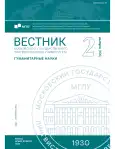Ergonymy of the Region: Dynamics and Modernity
- 作者: Poplavskaya T.V.1, Ilyicheva I.L.1
-
隶属关系:
- Minsk State Linguistic University
- 期: 编号 2(896) (2025)
- 页面: 44-51
- 栏目: Linguistics
- URL: https://journal-vniispk.ru/2542-2197/article/view/283959
- ID: 283959
如何引用文章
全文:
详细
The article examines ergonymic nominations of the Brest region in the diachronic aspect. The purpose of the study is to identify the main nominative models of ergonyms of three time periods (pre/post-revolutionary, pre/post-war, modern periods). As material, 450 ergonymic nominations of the specified time periods were analyzed. It was established that ergonyms represent a dynamically developing segment reflecting not only the main trends in nominative practice, but also verbally marking the collective way of perception and organization of regional space. The authors show that socio-economic transformations have a significant impact on nominative processes, contribute to the emergence of new models (conversational ergonyms).
作者简介
Tatyana Poplavskaya
Minsk State Linguistic University
编辑信件的主要联系方式.
Email: taniapoplavskaia@gmail.com
Doctor of Philology, Professor, Professor of the Department of Speech Science and Communication Theory
白俄罗斯Inna Ilyicheva
Minsk State Linguistic University
Email: ilitcheva@list.ru
PhD (Philology), Associate Professor,
Doctoral Candidate of the Department of Speech Studies and Communication Theory
参考
- Anisimov, N. O. (2018). The city in the discourse of semiotics. Juvenis scientia. Filosofskie i sociologicheskie nauki, 12, 33–35. (In Russ.)
- Vepreva, I. T., Kharitonova, A. V. (2023). Onomastic space of Ekaterinburg: level organization of regional identity markers. Voprosy onomastiki, 20(3), 184–189. (In Russ.)
- Golomidova, M. V. (2023). Ekaterinburg – Sverdlovsk – Ekaterinburg: the image of the city in the dynamics of toponymic text. Slovo.ru: baltijskij akcent, 14(1), 29–53. (In Russ.)
- Kryukova, I. V. (2007). Volgograd ergonymy in the diachronic aspect. Vestnik VolGU. Seriya 2, 6, 21–26. (In Russ.)
- Shimkevich, N. V. (2002). Russian commercial ergonymy: pragmatic and linguocultural aspects: PhD abstract. Ekaterinburg. (In Russ.)
- Chernyavskaya, V. E. (2023). Typographic landscape and pragmatics typographic variability. Science Journal of Volgograd State University. Linguistics, 22(5), 89–100. (In Russ.)
- Biyumena, A. A. (2022). Pragmatic categories of printed media discourse. Minsk: Minsk State Linguistic. (In Russ.)
- Chernyavskaya, V. E. (2023). Typography as a social index: the Soviet landscape in modern Russian discourse // ΠΡΑΞΗMΑ. Problemy vizual’noj semiotiki (ΠΡΑΞΗMΑ. Journal of Visual Semiotics), 2(36), 50–73. (In Russ.)
- Poplavskaya, T. V. (2019). Multicultural identity in the context of the urban landscape. Rusistika, 17(2), 213–228. (In Russ.)
- Poplavskaya, T. V. (2018). City pragmatics: a sign as a replica. In Uchenye zapiski UO VGU im. P. M. Masherova (vol. 28, pp. 171–173). (In Russ.)
- Poplavskaya, T. V., Shilej, A. V. (2022). Translinguality as an explication of the appeal of urban names. Polilingvial’nost’ i transkul’turnye praktiki, 19(4), 596–602. (In Russ.)
- Shmelyova, T. V. (2019). Polycode character of the urban onomasticon. Kommunikativnye issledovaniya, 6 (1), 51–66. (In Russ.)
- Krasnyh, V. V. (2003). «Ours» among «strangers»: myth or reality? Moscow : Gnozis. (In Russ.)
- Zabrodina, G. D., Voloshinov, A. V. (2016). Spatial symbolism as the archetypal basis of the cultural landscape // Obshchestvo. Sreda. Razvitie, 1, 111–115. (In Russ.)
- Voroshilova, M. B. (2013). Political creolized text: keys to reading Ekaterinburg. (In Russ.)
补充文件










